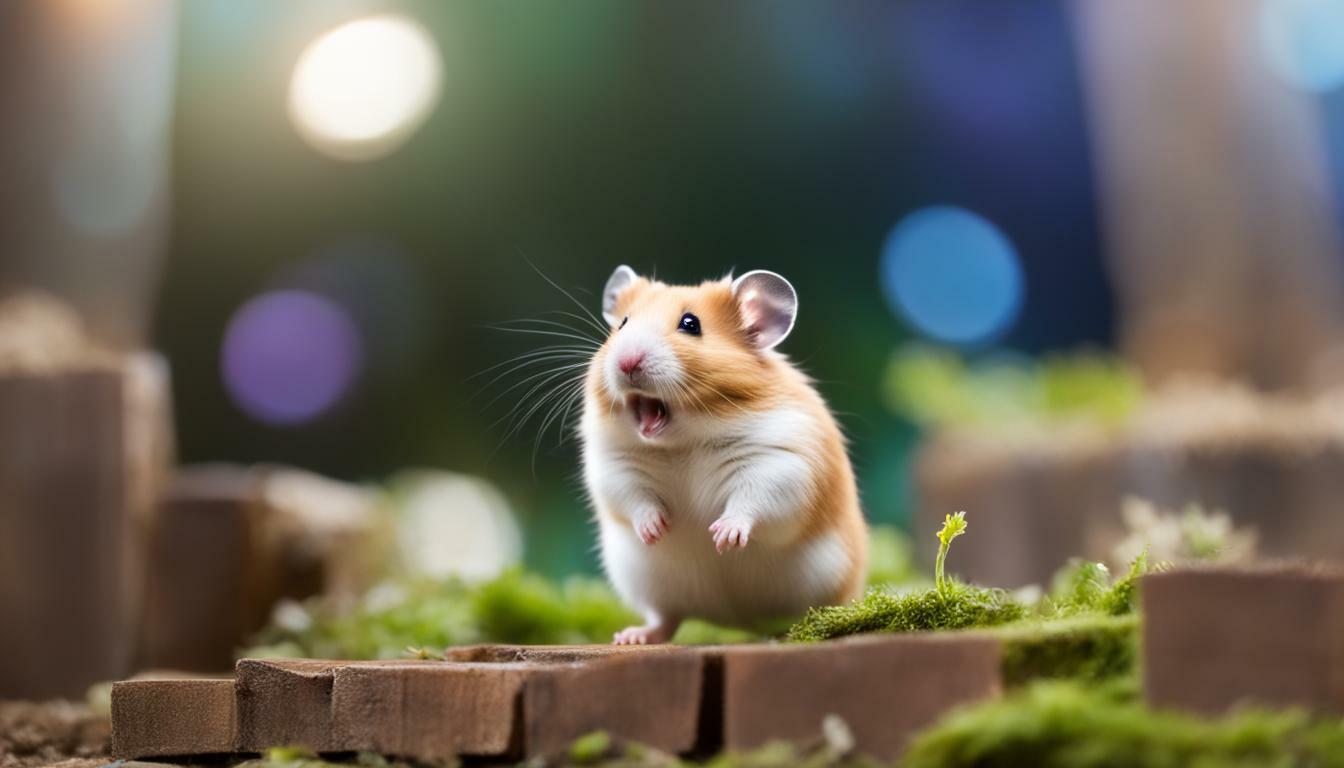Have you ever wondered if hamsters have the ability to jump? These energetic little creatures love to explore their surroundings and engage in various physical activities, including jumping and climbing. In this article, we will dive into the fascinating world of hamster jumping behavior and explore their impressive capabilities. So, let’s get started!
Key Takeaways:
- Syrian hamsters can jump up to 15 inches, while dwarf hamsters typically jump between 7 and 11 inches.
- Hamsters have a natural instinct to climb and jump, which serves purposes like exercise, seeking attention, escaping their cages, and avoiding contact.
- Hamsters can even climb on cage wires and walls, showcasing their agility and vertical leaping abilities.
- Creating a safe environment with soft landings, appropriate distances between platforms, and careful handling is essential for encouraging your hamster’s jumping behavior.
- Remember to observe your hamster’s capabilities and limitations to ensure their safety while allowing them to enjoy their natural talents.
The Jumping Capabilities of Hamsters
Hamsters are known for their energetic nature, and their jumping ability is no exception. These small rodents possess the astonishing talent of leaping to impressive heights, allowing them to explore their surroundings with agility and enthusiasm.
Syrian hamsters, also known as Teddy Bears, are particularly skilled jumpers, capable of vaulting up to 15 inches in the air. Their larger size and robust build contribute to their impressive jumping capabilities. On the other hand, dwarf hamsters, such as Roborovskis or Campbell’s dwarfs, can jump between 7 and 11 inches, showcasing their agility despite their smaller stature.
Hamsters not only excel at vertical jumping but also possess the ability to climb on cage wires and even walls. Their nimble bodies and sharp claws allow them to scale various surfaces, showcasing their natural instincts for exploration and adventure.
| Hamster Type | Jumping Height |
|---|---|
| Syrian Hamster | Up to 15 inches |
| Dwarf Hamster | 7 to 11 inches |
Hamsters jump for a multitude of reasons. It is their way of exercising their agile bodies and expending their energy. Jumping also serves as a means of seeking attention from their owners or fellow hamsters. Moreover, hamsters may jump in moments of excitement or aggression, using their jumps as a display of their emotions. Additionally, jumping allows hamsters to escape from their cages or avoid undesirable contact, serving as a form of self-defense.
To encourage your hamster’s jumping behavior, it is crucial to create a safe and stimulating environment. Ensure there are soft landing surfaces, such as bedding or cushions, to protect your furry friend from injuries. Providing platforms or perches with safe distances between them allows hamsters to practice their jumps and explore their surroundings confidently. Finally, remember to handle your hamster with care, respecting their boundaries and making jumping experiences positive and enjoyable for them.
Climbing and Jumping: A Natural Instinct
Climbing and jumping are natural instincts for hamsters, serving various purposes in their daily lives. These small, energetic creatures love to explore their surroundings and engage in acrobatic movements. Hamsters possess excellent agility and balance, allowing them to navigate vertical spaces with ease. By climbing and jumping, hamsters fulfill their physical exercise needs and express their natural behaviors.
Hamsters are known for their remarkable jumping abilities. Syrian hamsters, the larger breed, can jump up to 15 inches, showcasing their impressive leaping skills. On the other hand, dwarf hamsters typically jump between 7 and 11 inches, demonstrating their agility despite their smaller size. These jumps serve as a means of transportation, allowing hamsters to move from one elevated surface to another and explore their surroundings.
In addition to their jumping abilities, hamsters have the innate ability to climb. They can effortlessly climb on cage wires, utilizing their sharp claws for grip and balance. This climbing instinct also extends to vertical surfaces, where hamsters can climb on walls if given the opportunity. For hamsters, climbing and jumping provide mental stimulation, exercise, and a means of communication.
| Hamster Breed | Jumping Height |
|---|---|
| Syrian Hamster | Up to 15 inches |
| Dwarf Hamster | 7 to 11 inches |
Hamsters jump for various reasons. They may engage in jumping behavior to exercise their muscles, seeking attention from their owners, express excitement or aggression, or escape their enclosure for exploration. By providing a safe environment, hamster owners can encourage their pet’s jumping behavior. This includes ensuring soft landing surfaces to minimize the risk of injury, providing appropriate distances between platforms for comfortable jumps, and handling hamsters gently to foster a positive experience.
The Heights Hamsters Can Reach
Hamsters are capable of impressive heights in their jumps, with variations depending on their breed. Syrian hamsters, also known as teddy bear hamsters, have been known to jump as high as 15 inches. These larger hammies are known for their powerful hind legs, which allow them to propel themselves to remarkable heights.
Dwarf hamsters, on the other hand, have a slightly smaller stature but are still skilled jumpers. Roborovski and Campbell’s dwarf hamsters typically jump between 7 and 11 inches, showcasing their agility and athleticism. Despite their diminutive size, these tiny dynamos can still reach impressive heights in their jumps.
To give you a better understanding of the heights hamsters can reach, here’s a table summarizing the average jumping capabilities of different hamster breeds:
| Hamster Breed | Average Jumping Height |
|---|---|
| Syrian (Teddy Bear) Hamsters | Up to 15 inches |
| Roborovski Dwarf Hamsters | 7 to 9 inches |
| Campbell’s Dwarf Hamsters | 9 to 11 inches |
It’s important to note that while hamsters can reach impressive heights, it’s essential to provide a safe environment for their jumping activities. Soft landings are crucial to prevent any injuries, so be sure to provide bedding or cushioned surfaces in their play areas. Additionally, it’s important to carefully observe your hamster’s capabilities and limitations to ensure their safety.
Vertical Leaping and Hamsters
Hamsters excel in vertical leaping, using their strong legs and nimble bodies to climb and jump with ease. These small furry creatures are natural acrobats, making their way effortlessly up cage wires and even scaling walls. Their agility is truly impressive, and it’s fascinating to watch them navigate their environment with such grace.
When it comes to vertical leaping, Syrian hamsters have been known to reach heights of up to 15 inches, while dwarf hamsters typically jump between 7 and 11 inches. This remarkable jumping ability allows them to explore their surroundings, reach new places, and satisfy their natural instincts.
Hamsters engage in vertical leaping for various reasons. It’s a way for them to exercise and stay active, which is essential for their physical and mental well-being. Jumping also serves as a means of seeking attention, expressing excitement or aggression, and avoiding contact when necessary.
| Reasons for Hamster Jumping |
|---|
| Exercise |
| Seeking attention |
| Excitement or aggression |
| Avoiding contact |
As a responsible hamster owner, it’s important to provide a safe environment that encourages your furry friend’s jumping behavior. Ensure there are soft landing surfaces, such as bedding or cushions, to prevent any potential injuries from jumps. Create a setup with appropriate distances between platforms, allowing your hamster to leap comfortably. Additionally, handle your hamster with care, providing a positive and nurturing experience when interacting with them.
By understanding and embracing your hamster’s natural talents, such as their vertical leaping abilities, you can provide them with an enriching and stimulating environment that supports their physical and mental needs. Encourage their jumps, provide opportunities for exercise, and watch them thrive as they explore and conquer their vertical world.
Reasons for Hamster Jumping
Hamsters jump for a multitude of reasons, each serving a specific purpose in their daily lives. These energetic creatures embrace jumping as a form of exercise, allowing them to stay physically active and maintain a healthy lifestyle. Jumping also serves as a method for seeking attention, as hamsters love to show off their acrobatic abilities and impress their owners with their daring leaps.
Escaping their cages is another reason why hamsters engage in jumping behavior. With their innate curiosity, hamsters are natural explorers who crave adventure. Jumping enables them to venture beyond their enclosures and satisfy their desire to explore new environments. Whether it’s a hop onto a nearby platform or a leap onto a higher surface, hamsters use their jumping skills to navigate their surroundings and escape confinement.
Additionally, hamsters may jump out of excitement or aggression. When they are feeling particularly playful or stimulated, hamsters may exhibit bursts of energy that prompt them to jump and hop around. Similarly, in situations of aggression or fear, jumping can be a defensive mechanism for hamsters, allowing them to avoid physical contact and potential threats.
Hamster Jumping Habits
It is important for hamster owners to understand and appreciate their pets’ jumping habits. By recognizing the reasons behind these jumps, owners can create a safe and stimulating environment that encourages their hamster’s natural behaviors. Providing soft landings, such as cushioned bedding or hay, ensures that jumps are not harmful to their little paws. Placing platforms at safe distances can also allow hamsters to showcase their jumping skills without risking injury.
Furthermore, careful handling plays a significant role in fostering a positive jumping experience for hamsters. By gently and securely holding their furry friends, owners can instill trust and confidence, making the hamsters more willing to engage in jumping behavior. Regular interaction and playtime can further strengthen the bond between owners and their hamsters, leading to more joyful and frequent jumping episodes.
| Hamster Breed | Jumping Height (inches) |
|---|---|
| Syrian Hamsters | Up to 15 inches |
| Dwarf Hamsters | 7 to 11 inches |
It’s remarkable to witness the remarkable jumping abilities of hamsters, particularly Syrian hamsters who can jump heights of up to 15 inches. Dwarf hamsters may not reach the same heights but can still perform jumps between 7 and 11 inches, showcasing their agility and impressive physical capabilities.
Overall, embracing and encouraging a hamster’s jumping habits is essential for their overall well-being. By understanding their motivations and providing a nurturing environment, owners can create a stimulating and safe space where hamsters can showcase their natural talents and enjoy a fulfilling life filled with exciting jumps and leaps.
Encouraging Hamster Jumping Behavior
If you want to see your hamster’s jumping skills in action, there are several ways you can encourage this behavior. Hamsters are energetic and love to explore and climb, so providing them with opportunities to jump is essential for their physical and mental well-being. Here are some effective techniques to encourage your hamster’s jumping:
- Set up a hamster obstacle course: Create a fun and challenging environment for your hamster by setting up an obstacle course. Use tunnels, ramps, platforms, and bridges to create different levels for your hamster to jump between. This will encourage them to practice their jumping skills and provide them with mental stimulation.
- Use toys and treats as incentives: Hamsters are motivated by rewards, so use toys or treats as incentives to encourage jumping. Place a toy or treat on a higher platform or at the end of a ramp, enticing your hamster to jump to reach it. This will not only enhance their jumping abilities but also strengthen their bond with you through positive reinforcement.
- Provide safe landing surfaces: Ensure that your hamster has soft landing surfaces to jump onto. Place fluffy bedding or cushions at the base of platforms or ramps to cushion their landings. This will prevent injuries and make your hamster feel more confident about jumping higher.
Remember, safety is paramount when encouraging your hamster’s jumping behavior. Avoid excessive heights that may cause injuries and always supervise your hamster during their jumping adventures. Observe their capabilities and limitations to ensure their safety. If your hamster shows signs of fear or discomfort, provide them with smaller jumps and gradually increase the difficulty as they become more comfortable. By creating a safe and stimulating environment, you can help your hamster unleash their natural jumping instincts and enjoy their playful nature to the fullest.
**Table: Recommended Jumping Techniques**
| Technique | Description |
|———–|————-|
| Hamster Obstacle Course | Create a challenging environment with tunnels, ramps, platforms, and bridges for your hamster to jump between. |
| Toy and Treat Incentives | Use toys or treats as rewards to motivate your hamster to jump higher. Place them on higher platforms or at the end of ramps to encourage jumping. |
| Soft Landing Surfaces | Provide fluffy bedding or cushions at the base of platforms or ramps to cushion your hamster’s landings and prevent injuries. |
Safe Jumping Practices
While hamsters have impressive jumping abilities, it’s vital to ensure their safety when engaging in this behavior. Creating a safe environment for your furry friend will not only prevent injuries but also enhance their jumping experience. Here are some key practices to follow:
- Provide Soft Landings: Place soft bedding or cushions at the base of elevated platforms to cushion your hamster’s landing. This will minimize the impact and reduce the risk of injury.
- Maintain Safe Distances: Ensure that the height between platforms is suitable for your hamster’s jumping capabilities. The distance should be challenging yet within their reach, preventing strain or falls.
- Observe Your Hamster: Pay attention to your hamster’s behavior and jumping abilities. Each hamster is unique, and their capabilities may vary. By observing their comfort level and limitations, you can adjust the environment accordingly to ensure their safety.
- Handle with Care: When interacting with your hamster, remember to handle them gently and avoid sudden movements. This will build trust and confidence, encouraging them to jump without fear or hesitation.
By implementing these safe jumping practices, you can provide your hamster with a stimulating and secure environment to showcase their natural talents. Remember, their safety should be a top priority as you enjoy watching them explore, climb, and leap with enthusiasm.
| Hamster Type | Jumping Height (in inches) |
|---|---|
| Syrian Hamster | Up to 15 inches |
| Dwarf Hamster | Around 7 to 11 inches |
Conclusion
Hamsters are incredible jumpers, and understanding their capabilities can enhance your appreciation for these delightful pets. Whether you own a Syrian hamster or a dwarf hamster, you’ll be amazed at their jumping abilities. Syrian hamsters, being larger in size, can jump up to an impressive 15 inches, while dwarf hamsters typically reach heights of 7 to 11 inches.
Not only can hamsters jump vertically, but they also possess remarkable climbing skills. They can climb on cage wires and even scale walls, showcasing their agility and natural instincts. Their jumping behavior serves various purposes, including exercise, seeking attention, escaping their cages, excitement or aggression, and avoiding unwanted contact. It’s truly fascinating to witness how these small creatures utilize jumping as a form of communication.
As a hamster owner, it’s important to create a safe environment that encourages your pet’s jumping behavior. Provide soft landing surfaces to minimize the risk of injuries and ensure there are safe distances between platforms for your hamster to leap from. Additionally, handling your hamster with care can foster a positive jumping experience and strengthen the bond between you and your furry friend.
In conclusion, embrace and enjoy your hamster’s natural talents. Their jumping and climbing abilities are not only impressive but also a vital part of their physical and mental well-being. By understanding and accommodating their jumping needs, you can create a happy and fulfilling life for your beloved hamster.
FAQ
Can hamsters jump?
Yes, hamsters are energetic and love to jump and climb.
How high can hamsters jump?
Syrian hamsters can jump up to 15 inches, while dwarf hamsters can jump about 7 to 11 inches.
Why do hamsters jump?
Hamsters may jump for various reasons, such as exercise, seeking attention, escaping a cage, excitement or aggression, and avoiding contact.
Do hamsters climb?
Yes, hamsters can climb on cage wires and even walls.
How can I encourage my hamster’s jumping behavior?
Provide a safe environment with soft landings, safe distances between platforms, and careful handling to encourage your hamster’s jumping behavior.




